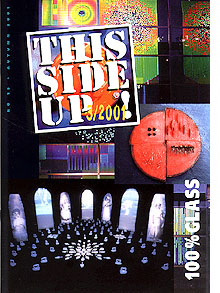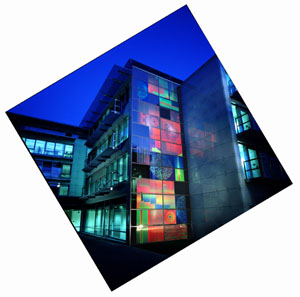Building with Light: Holography, glass and architecture
 In September last year a massive glass and holographic wall was installed in Bonn, Germany. It brought together glass technicians, holographic artist and physicist who worked together to construct the 21st Century equivalent of a monumental stained glass wall.
In September last year a massive glass and holographic wall was installed in Bonn, Germany. It brought together glass technicians, holographic artist and physicist who worked together to construct the 21st Century equivalent of a monumental stained glass wall.One of the main problems which has faced holography, apart from the banality of the imagery and apparent lack of any content beyond the illusion, has been size. They were never large enough. Almost as soon as these three-dimensional images appeared, in the late 1960’s, critics demanded larger scale, larger images, larger everything. How else would we be able to use them as giant advertising bill boards, cover buildings with holograms or use them in public art?
Since those early critics became excited, and dismissive, about holography the world and the medium of holography has changed. Not only has the technology, which makes holography possible, become more flexible, but also the attitude of artists and, to some extent, architects, has altered . A good example of this slow, but visible, change is the commissioning and installation of a holographic glass wall which clads the external face of a German research centre.
The wall measuring 13 x 5 meters covers the entire side of a new extension to the German Research Association’s (Deutsche Forshungsgemeinschaft, DFG) building in Bonn. The installation, entitled EyeFire (AugenFeuer), is the work of German artist Michael Bleyenberg and was produced in association with the Institute for Light and Building Technology, (ILB), which is based at the University of Cologne. Artists and architects have wanted to use holography on the outside of buildings for many years but the problems of physical scale, weather proofing, lighting and basic technical limitations have subdued several exciting projects. Here Bleyenberg succeeded because of his sensitivity to the problems involved and the novel holographic technique made available by the ILB.
When we think of holography we naturally think of 3-D images that look like the original objects which were recorded, but the medium can achieve other effects. it can, for example, produce pure spectral colours and patterns which appear to float in space. Artists do not have to be restricted to simply ‘reproducing’ 3-D reality. Bleyenberg, who has exhibited his more traditional abstract paintings in many group and solo shows, became attracted to holography at the Academy of Media Art Cologne where he learned the medium as part of his post graduate studies there. The Academy is one of the few institutions in Europe to offer creative holography as part of its Media Arts studies. He immediately understood the potential of ‘painting with light’ and began exploring some of the possibilities. Some of his early large scale works, meter square holograms which ‘captured’ entire rooms, were shown at Art Cologne, the international Art fare held in the city each year.
His involvement in the Bonn project came about because Professor Jörg Gutjahr, of the ILB, had received a commission to produce holograms for the new DFG building extension. The ILB had developed a computer controlled holographic technique which can generate small holographic pixels. The colour of these tiny picture elements can be pre calculated so that a specific colour can be seen when viewing the hologram from a specific angle. They are also extremely bright. By recording many of these holographic pixels next to each other a large, intense, holographic pattern can be created. Gutjahr has worked with several artists previously and was part of the team which produced a large holographic roof display on an electricity building in Cologne’s Media Park so he was familiar not only with the production process for large scale installations but the qualities needed to work with artists, engineers and architects.
 Eyefire was created by Bleyenberg to take advantage of the ILB’s holographic pixel system. During the summer of 1999 he began to produce several ‘sketches’ using flat computer graphics to visualise and experiment with colour and pattern combinations. A meter square ‘test’ hologram was produced, based on these early ideas, and presented to the DFG, From this point on the speed of the project accelerated. What was unusual about this holographic light wall was that it had never been attempted on this scale and for this sort of vertical building cladding. One of the problems that Bleyenberg found was that almost everything they were doing was being done for the first time. He did find that the holographic technology placed restrictions on him as an artist but he was able to embrace these and overcome the media obstacles, helped greatly by his 25 years experience in painting.
Eyefire was created by Bleyenberg to take advantage of the ILB’s holographic pixel system. During the summer of 1999 he began to produce several ‘sketches’ using flat computer graphics to visualise and experiment with colour and pattern combinations. A meter square ‘test’ hologram was produced, based on these early ideas, and presented to the DFG, From this point on the speed of the project accelerated. What was unusual about this holographic light wall was that it had never been attempted on this scale and for this sort of vertical building cladding. One of the problems that Bleyenberg found was that almost everything they were doing was being done for the first time. He did find that the holographic technology placed restrictions on him as an artist but he was able to embrace these and overcome the media obstacles, helped greatly by his 25 years experience in painting.After the initial presentation to the DFG it then took six months for the project to be realised. Bleyenberg produced final computer graphic designs which were converted into thousands of holographic pixels and recorded onto 26 panels each measuring 1 x 2.5 meters. Each of these panels was embedded between a glass mirror backing and clear cover glass sheet. The edges of this glass ‘sandwich’ were sealed and framed ready to be mounted onto the outside of the featureless concrete wall which made up part of the new extension. Without the glass construction, in which the holographic sheets are embedded, this project would not have been viable as an external construction. Holographic surfaces are extremely sensitive to moisture. Any rain entering the wall and making contact with the hologram would have distorted the image and in extreme cases destroyed it completely. Not only did Bleyenberg need to produce a workable visual image which took advantage of the technology, he needed a design which would complement the architecture of the new building, which itself needed to work well with the original 1950’s building architecture.
Although the project had taken a little over a year from original ‘sketches’ to final installation the 26 glass panels were installed on site in a singe day!
Holograms are only visible when illuminated with light from a specific direction and this wall is no exception. During the day ambient and direct sunlight bounces off the mirrored glass backing of each panel, travels through the thousands of tiny holograms and creates an ever changing pattern of colour. Each holographic pixel acts a little like a glass prism, taking the white light which passes through it and splitting it into spectral colours. As an observer moves past the wall, their eyes will ‘pass through’ different parts of the spectrum generated by each holographic pixel. Bright sunlight will produce intense spectral colours and subdued diffused light will create softer, more pastel colours. This is a high profile site situated directly opposite the entrance to a conference centre, so visitors are constantly moving past it and experiencing the colour shifts. As Bleyenberg comments “I like the hovering of those images, the illusion of the absence of gravity and the tension of seeming instability under stable conditions”.
At night 6 search lights flood the holograms with light (3 from the roof of the conference centre opposite and 3 from the floor area directly in front of the wall). The effect is kinetic. The flat featureless wall disappears, replaced by intense shifting graphic images,patterns and colours.
The potential for this type of holographic installation is immense and, like all pioneering projects, was not easy to realise. It required the vision and enthusiasm of an organisation willing to commission something new and challenging. The DFG, which promotes and financially supports scientific research projects, advises government and promotes the relationship between German research to foreign science organisations, wanted an installation which would reflect, through technique and content, their interest in science and research. EyeFire does just that. The project brought together this commissioning vision, the skills and sensitivity of an artist who had begun to understand holography’s potential for public art, the ILB which developed the recording technology to make this type of ‘pixel’ installation possible and the glass companies and technicians capable of embedding each holographic sheet ready for installation. EyeFire shows holography’s potential and offers artists, designers and architects interested in the potential of light and colour, another technique with which to experiment.
Further information about EyeFire/AugenFeuer can be found at:
www.holonet.khm.de/eyefire
Published in This Side Up, No.,15, September 2001, pp2-4. ISSN 1389 1707.
The article, "Windows with Memories: Creative holography in the real world"
is also available here.
Details about the magazine and subscriptions:
This Side Up
PO Box 423
NL-5550 AK Valkenswaard
The Netherlands
Phone-Fax + 32 (0)11 642837
E-mail: info@this-side-up-magazine.com or fenestra@euronet.be
Visit their website at: www.this-side-up-magazine.com
| exhibits | gallery | writing | teaching | biography | contact |